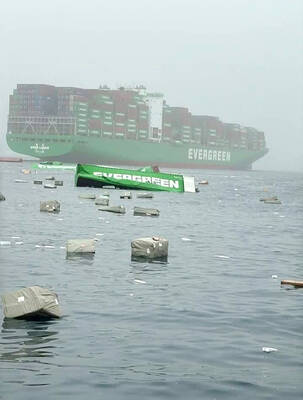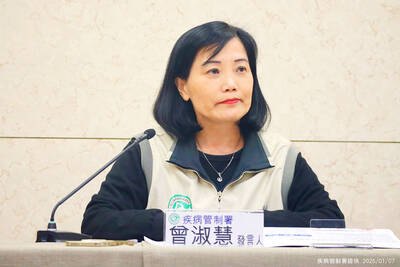Every year when the northeastern monsoon blows in late autumn, townships located along downstream stretches of the Jhuoshuei (濁水), Dajia (大甲) and Da-an (大安) rivers tend to suffer from serious dust storms. This year has been no different.
Among the hardest-hit towns are Yunlin County’s Siluo (西螺), Erlun (二崙), Lunbei (崙背) and Mailiao (麥寮) townships located near the Jhuoshuei River estuary and Taichung County’s Dajia Township (大甲) on the estuary of the Dajia and Da-an rivers.
“The dust storm problem is especially serious in riverside towns,” Yunlin County Commissioner Su Chih-fen (蘇治芬) said.
The county government has sponsored forums at elementary schools in those townships to teach schoolchildren how to cope with dust storm damage, Su said.
Hsukuang Elementary School in Erlun and Fengjung Elementary School in Lunbei are among the hardest-hit schools.
Lin Huang-jung (林煌榮), the principal at the Hsukuang school, said the school has had to spray water on its grounds a number of times every day during the northeastern monsoon season.
“All classroom windows facing north have to be closed when the seasonal winds blow,” Lin said. “Even then, our desks and chairs are often covered by dust.”
During breaks, schoolchildren play outdoors.
“We always remind them to wear face masks, but our words oftentimes fall on deaf ears,” Lin said.
Schoolchildren tend to return home with their outfits full of dust, the head of the school’s parent association said, and many students often complain about sore throats and irritated eyes.
Two strategies are being tested to counter dust storms: building forest wind breaks and building dams to raise water levels and so prevent winds from blowing up sand from dry riverbeds.
Officials from the Fourth River Basin Management Bureau, which is responsible for managing the Jhuoshuei River, said the bureau has launched a project to plant 7km of trees along the river’s northern bank in Changhua County and the southern bank in Yunlin County to shield the riverbed from the winds.

CARGO LOSS: About 50 containers at the stern of the ‘Ever Lunar’ cargo ship went overboard, prompting the temporary closure of the port and disrupting operations Evergreen Marine Corp, Taiwan’s largest container shipper, yesterday said that all crew members aboard the Ever Lunar (長月) were safe after dozens of containers fell overboard off the coast of Peru the previous day. The incident occurred at 9:40am on Friday as the Ever Lunar was anchored and waiting to enter the Port of Callao when it suddenly experienced severe rolling, Evergreen said in a statement. The rolling, which caused the containers to fall, might have been caused by factors including a tsunami triggered by an earthquake in Russia, poor winter sea conditions in South America or a sudden influx of waves,

The Ministry of Culture yesterday officially launched the “We TAIWAN” cultural program on Osaka’s Nakanoshima sandbank, with the program’s mascot receiving overwhelming popularity. The cultural program, which runs from Aug. 2 to 20, was designed to partner with and capitalize on the 2025 World Expo that is being held in Osaka, Japan, from April 13 to Oct. 13, the ministry said. On the first day of the cultural program, its mascot, a green creature named “a-We,” proved to be extremely popular, as its merch was immediately in high demand. Long lines formed yesterday for the opening

The Taipei Summer Festival is to begin tomorrow at Dadaocheng Wharf (大稻埕), featuring four themed firework shows and five live music performances throughout the month, the Taipei Department of Information and Tourism said today. The festival in the city’s Datong District (大同) is to run until Aug. 30, holding firework displays on Wednesdays and the final Saturday of the event. The first show is scheduled for tomorrow, followed by Aug. 13, 20 and 30. To celebrate the 30th anniversary of Disney Pixar's movie Toy Story, the festival has partnered with Walt Disney Co (Taiwan) to host a special themed area on

BE CAREFUL: The virus rarely causes severe illness or death, but newborns, older people and those with medical conditions are at risk of more severe illness As more than 7,000 cases of chikungunya fever have been reported in China’s Guangdong Province this year, including 2,892 new cases last week, the Centers for Disease Control (CDC) yesterday said it is monitoring the situation and considering raising the travel notice level, which might be announced today. The CDC issued a level 1 travel notice, or “watch,” for Guangdong Province on July 22, citing an outbreak in Foshan, a manufacturing hub in the south of the province, that was reported early last month. Between July 27 and Saturday, the province reported 2,892 new cases of chikungunya, reaching a total of 7,716